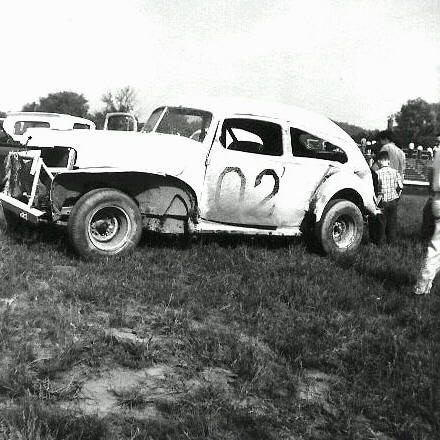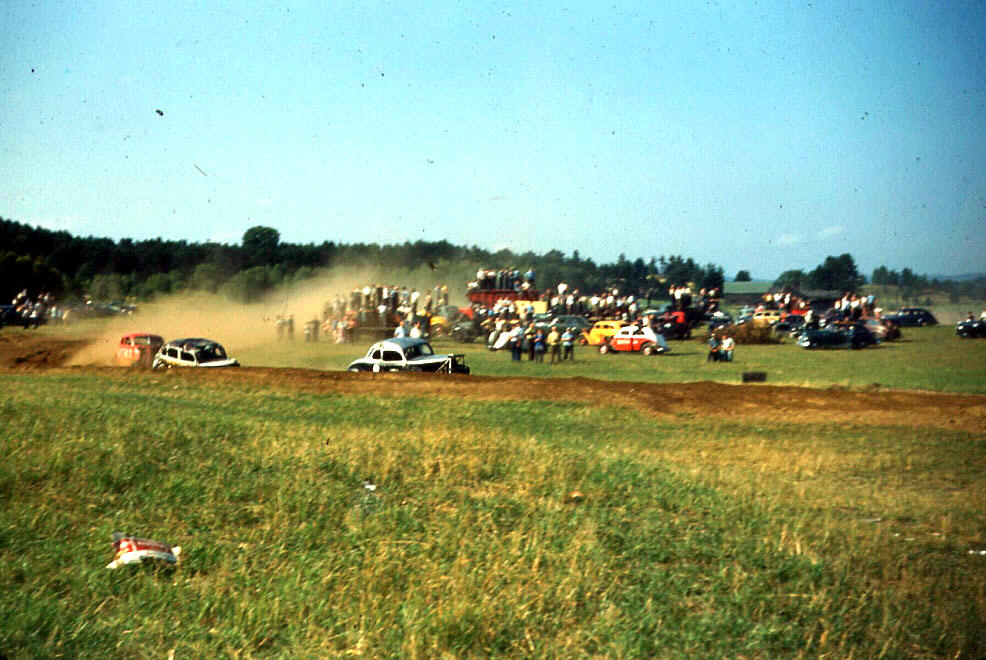
THE
BILL'S BACK IN TIME COLUMN PAGE
Copies of my column in Mark Thomas' "Racin'
Paper"
BILL’S BACK IN TIME
By Bill Ladabouche
Site Column #46 from My Column 61
THE GOOD OL’ DAYS ? MAYBE… MAYBE NOT
Just sitting around listening to some of the older guys talk, it’s a wonder that a single one of them survived early racing to tell about it. Not only were precautions almost nonexistent, but they seemed crazier than today’s more businesslike bunch around stock car racing. Rules, if there were many, were looser, and budget were often so tight that necessity was the mother or invention. Some of the earlier racing machines were an absolute marvel of technology. [It’s a marvel they even ran, let alone compete].

Many of the cars were an absolute marvel of technology, like this beauty of Corinth, NY’s Ken Guilder. Believe it or not the car was not rolled recently – it looked like that all season. [Ladabouche Photo]
Early tracks were about as bad as early cars. People often stood right on the edge of the racing surface as poorly-built cars careened past them. Even when more organized facilities opened, the fences were woefully inadequate. Most of the time, early promoters had to figure where to invest their sparse funds, and these funds seemed to go into a.) some sort of public address system, some sort of grandstands, and maybe a water truck. A track like Pico Raceway, in Rutland, Vermont, was the exception to the rule, having a tall cement retaining wall and excellent bleachers.

Cars race around the track at Lyndonville, Vermont’s Websters Flats. Note how close people are standing to the racing surface. [Courtesy of the Bigelow Family]
As time went on, cars begin to be braced better, but not many other improvements were made. The fuel of the day was usually a beer keg, although veterans like Butch Jelley have told me about having an open gas can with a rag stuffed in the top, riding with them inside a jalopy. There were some horrific race car fires, even with some of the better – built cars like Ken Shoemaker’s Drellos 111 and Rene Charland’s championship #3, the “French Barbeque” car. Even early attempts at fuel cells weren’t much. Bob Dragon’s first modified, a former Bill Wilson car from Orange County Speedway, had a homemade job – a homemade metal box with about six five gallon plastic gas cans sawed off at the top to create compartments.
This rig, brought to Fairmont Speedway by the usually-NASCAR-legal Jim Koehler, had a beer keg for a gas tank. [Ladabouche Photo]
Drivers were apt to experiment with exotic fuel mixtures, as well, - something they probably couldn’t get away with today. Beaver Dragon tells of receiving a liquid from a friend to add to his gas with the first Dragon race car, around 1955. Whatever it was, the donor used it for blasting in a nearby stone quarry. Beaver said the car ran like hell with the stuff, but his Malletts Bay Speedway competitors began to be suspicious when the car would come into the pits and – despite everyone’s best efforts, would just keep running. They learned to stall it out quickly after a while.

The first Dragon stock car would [literally] blast around Malletts Bay. Maybe that helped him win the first race he was ever in. [Bourgeois Family Family]
As I said before, necessity was sometimes the mother of invention – especially in places like Bear Ridge Speedway, a haven for racers with low budgets. The story goes around that one guy got to the track and the steering wheel in his old coupe fell right off while unloading. Reportedly, he clamped on a pair of vice grips and went out to compete. There is also the story of Orange, Vermont’s classic shoestring operator, Chester T. Wood, who was seen plugging a hole in his radiator with a hotdog.
Stories of guys taking matters into their own hands with moments to spare abound if you can find where the old guys sit before the races start. Wes Moody [not even that old a guy yet] tells a story of having a gas tank leak at Fonda, with fellow Saranac Lake, New Yorker Jim Hoyt. Hoyt, who did manage to build a car well enough to survive one of the worst wrecks Fonda ever had, relates how they filled the tank completely full of gas so as to have no air space for fumes. Then Moody attacked the tank with a torch. He says guys were running for lives in all directions as the fuel residue in the outside caused fire spatter and no small amount of noise. But both are still here today to tell the tale, although Fonda guys avoid them, for some reason.
Jim Hoyt would ran this car when he had the famous Fonda crash. [Moody Collection]
Sometimes the safety issue was both perplexing and tragic. A car owner named Bob Zimmerman field a number of cars with the numbers 72 and 172, out of the Albany, New York area. Zimmerman cards ran at Fonda, and a few other surrounding tracks with the veteran Carl Fink, a relative of Bob’s, with Zimmerman, himself, and with the immensely – popular Pepper Eastman, of Madison, NY. Clearly, Zimmerman could construct a tough car. Fink is in the Fonda history book as having one of the track’s worst crashes with a good – looking #71 sedan.
However, Zimmerman blossomed out with one last car, which looked like it might be around a 1937 Ford. Fink tried the car out, but he didn’t get a good feeling when he drive and decided to pass on the job. This lured Eastman away form his customary #181, the car whose number and lore inspired Lew Boyd to name his publishing firm Coastal 181. Pepper was driving the car at Fonda in the mid 1960’s when he had a wreck that, at first, didn’t seem that bad. But, he perished from the crash. The car would have withstood a huge rollover, no doubt, but Pepper hit the steering wheel, somehow and suffered internal injuries. Today, there are much better restraints.
The Zimmerman car is towed into Fonda around 1964 for Pepper Eastman to drive. A few weeks later, both the driver and the team would be gone. [Ladabouche Photo]
Stories about the old days of racing and their half – baked safety precautions make good stories for columnists like me: but too many young family men were lost – usually in contests for a few dollars’ purse. It is very romantic to think of starters like Art Prairie, of Airborne Speedway, who laughed with the drivers over their efforts t=o come as close to him on the track during starts as they could manage. We shake our heads in admiration over flaggers like Archie Blackadar and Chet Hames, running down the track between two lines of stock cars to begin a feature. But, then, you remember George Welch, a really on-the-ball young man who drove in the 1950’s and who was struck and killed flagging at a Capital District track in New York.
George Welch, at Fonda, giving out kiddie rides in his own #8. [John Grady Photo]
Racing today is whole lot different, if not a lot less varied. With the many [and expensive] safety features, we don’t see drivers and spectators getting hurt nearly as often…. and that is one of the good things. We also don’t see the fields of cars strung out at the finish as much as we used to. Often, a winner might be a lap ahead of second place. The crate engines, and the uniform chassis of today make for some very close . We may have sacrificed some of the characters like Chester T. Wood; but we have also managed to have a lot fewer George Welches, Pepper Eastmans, and all the other fatalities and serious injuries of the past. It’s a good thing, even if there is less variety.

This jalopy ran at Unity Speedway in the 1950’s. Good God ! What technology ! [Wicked Good Racin Website]
Return to the Columns Link Page
Return to the Main News Page